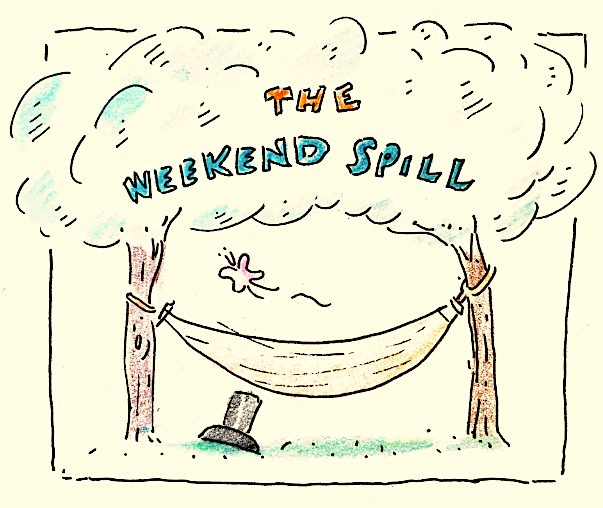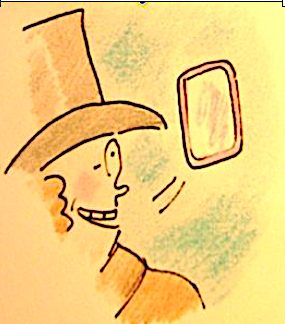The Tilley Watch Online, The Week Of January 24-28, 2022
An end of the week listing of contributors to newyorker.com features
The Daily Cartoon: Ali Solomon, Brendan Loper, J.A.K., Sophie Lucido Johnson, Ellis Rosen
.Barry Blitt’s Kvetchbook: “Mitch McConnell, Stripped Bare”
____________________________________________________________________
 60 Years Ago In The New Yorker
60 Years Ago In The New Yorker
On this snowy-blowy day in the northeast I thought it would be fun to time-travel back sixty years to the New Yorker issue of February 3, 1962, and take a quick look through that week’s offering.
The issue begins with a terrific cover from Anatol Kovarsky. I can imagine that Mr. Kovarsky, himself a fine artist as well as a cartoonist, really enjoyed coming up with this cover: bucketsful of color tossed out to the readership on an otherwise gloomy time of year.
The magazine’s old Table Of Contents, shown here, kept most of the contents secret until you came upon them in the issue. For instance, there was no listing of that week’s contributing cartoonists. I’ll list them now, just for fun:
Barney Tobey, George Price, Everett Opie, David Langdon, Frank Modell, Charles Saxon, James Stevenson, Mischa Richter, Stan Hunt, William O’Brian, Robert J. Day, Whitney Darrow, Jr., Joseph Mirachi, and Lee Lorenz.
Needless to point out – or maybe not needless — they are all men. There was not a single female New Yorker cartoonist contributing at that time, with two exceptions: the great Mary Petty, whose work, by then, was showing up only on the magazine’s covers, and Suzanne Suba, who mostly provided Spot drawings during her 24 year New Yorker career. Her wonderful ski lift spot (shown below) appears in this issue. Suba’s one-and-only cartoon was published in 1948 (she also contributed five covers). Ms. Suba put a lot of information into this very small drawing (well, who knows how large the original was).
Interesting (to me at least), that although I was practically just out of kindergarten in 1962, I eventually ended up meeting a number of the cartoonists in this issue: the aforementioned Mr. Kovarsky, as well as Frank Modell, Charles Saxon, James Stevenson, Mischa Richter, Joseph Mirachi, and of course, Lee Lorenz (The New Yorker’s art & cartoon editor during my first 24 years at the magazine).
Whitney Darrow, as has been noted here perhaps too often, drew an idea of mine in 1977. I never met Everett Opie, but did observe him wending his way through a New Yorker crowd at a party along the East River ( I stood a few feet away from Darrow at another New Yorker party, but we did not meet). I sat in a meeting in William Shawn’s office in the mid-1980s and was able to study the great Barney Tobey, as he himself studied the assembled from his perch on the somewhat famous couch in Shawn’s office (famous for usually being piled with work, and not a place to sit). I never met Stan Hunt, but loved hearing Jack Ziegler recounting to me in his Spill interview, how he ran into and introduced himself to Hunt while standing in line at the New Milford (Connecticut) U.S. Post Office years ago. The way Jack told it, it seemed as if we were all meeting Stan Hunt that day.
Going through the issue, I saw a good handful of the standard New Yorker set pieces of the time (most have continued on into our time): the desert island (from Mirachi), law (O’Brian) the door-to-door salesman (Lorenz), a bar drawing (Price), a restaurant (Saxon), and a husband-and-wife scenario (Hunt). Groundhog’s day gets a (somewhat dark) shout-out from Opie (it being the era of fallout shelters). the biggest amount of the magazine’s territory given over to one of its artists was the four page James Stevenson spread “Parents’ Night” (sandwiched between a John Updike story, “Unstuck” and a St. Clair McKelway story, “The Fireflies”).
And just as the magazine was into its last few pages (page 102 out of 104 pages) along came this ad for James Thurber’s classic, The Last Flower, recently reissued in its original format. Somewhat bittersweet, as Thurber had passed away three months before this issue appeared.






